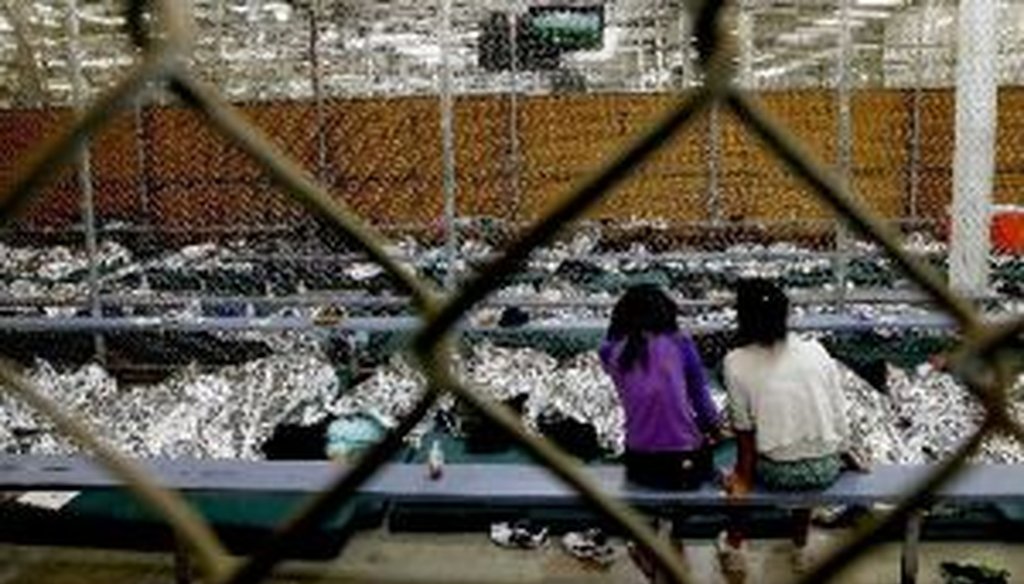Stand up for the facts!
Our only agenda is to publish the truth so you can be an informed participant in democracy.
We need your help.
I would like to contribute

Two girls watch a World Cup soccer match from their holding area in Nogales, Ariz., where hundreds of mostly Central American immigrant children are being processed and held.
The surge of unaccompanied children at the U.S. border, primarily coming from Honduras, Guatemala and El Salvador, has overwhelmed border security officials and pushed the limits of the U.S. legal system.
That's got elected officials talking about the underlying causes of the influx, as well as what should be done to address it.
PolitiFact has been fact-checking claims on immigration as the debate rages. While a few statements we've checked were verifiable, we also found a number of inaccurate statements. Here's a summary of our recent findings.
Why Central Americans are treated differently
Part of the reason for the large number of children being held at the border is that children from Central American countries can't be sent back as quickly as children from Mexico. There's a legal reason for that, said Rep. Henry Cuellar, D-Texas, on CNN's State of the Union on July 6.
"If you're a Mexican, you get sent back. Mother, kids, adults, you're sent back, but if you're from a noncontiguous country like the Central American countries, then the law says that you are going to be held, (and) Health and Human Services, they're going to place you. That's the law that we need to change right now."
The law he's talking about is the William Wilberforce Trafficking Victims Protection Reauthorization Act of 2008. President George W. Bush signed the law after it received bipartisan support in both the House and the Senate, as a measure to combat human trafficking worldwide.
The law lays out one procedure for child immigrants from contiguous countries, like Mexico and Canada. These children are processed for immediate return to their home country. In all other cases, the children are placed under the responsibility of the Secretary of Health and Human Services. These children are placed with family or in other residences while they await their immigration court date. Long story short, they get to stay in the United States.
The law seems to assume that alien children from noncontiguous countries were likely to be the victims of human trafficking, and it guarantees them access to legal counsel and child advocates.
Cuellar and other lawmakers intend to change the law, but Cuellar's description of it when he spoke is accurate. We rated his statement True.
How many children don't show up for hearings later?
A substantial chunk of the $3.7 billion President Barack Obama has requested from Congress for the border would be for increasing the courts' ability to handle the caseload of newly arrived children.
But Sen. Jeff Flake, R-Ariz., said in a July 8 interview on the PBS NewsHour that many children simply never show up for court hearings.
"When these kids are handed off from the Border Patrol, (the government's) role is to actually place those children in the care of a guardian or a family member. And then what the record shows is that they're told to appear later in court, where their case will be adjudicated. But 90 percent of them, 90 percent, do not then show up in court later."
Our research showed that the rate has ranged between 20 percent and 40 percent in recent years, settling in at about 30 percent in 2012, the most recent full year for which data are available. A more recent estimate for children specifically, made by the director of the office responsible for handling such cases, is that the current no-show rate for children is 46 percent.
That's still quite high, but it's only half what Flake said. We rated his claim False.
Projections for future border crossers
Homeland Security Secretary Jeh Johnson said the Obama administration's goal was to stop additional immigration and "stem the tide." Johnson repeatedly refused to say whether most of these unaccompanied minors would be deported during a July 6 interview on Meet the Press.
This led U.S. Rep. Raul Labrador, R-Idaho, to accuse Johnson of "making things up."
"He's saying that he's going to be able to stem it, and it's not going to reach 90,000 or between 60,000 and 90,000 children," Labrador said. "That's not going to happen. The administration's own estimates are that it's going to be about 60,000 to 90,000 this year, that it's going to increase to 150,000 to 200,000 next year. These are their own estimates."
The source for Labrador's numbers was a May 2014 internal memo from Deputy Border Patrol Chief Ronald Vitiello. According to news reports, the memo said that "90,000 minors would be apprehended this year and 142,000 next year."
When the internal memo became public in June, an agency official said it was "an internal, incomplete working document, neither signed nor made official."
A preliminary budget request from the Obama administration assumed increases would continue, but it did not state a particular figure for the number of children and noted that the money needed would change depending on the shifting situation on the ground.
On balance, we rated Labrador's statement Half True.
What Obama’s spending request would fund
Obama has asked Congress for $3.7 billion to address the immigration problem, but leading Republicans have expressed skepticism about the budget request.
"I'm not going to vote to approve $3.7 billion for the president to hire more lawyers and to squander in a way that he has designed," said Rep. Steve King, R-Iowa. "There is nothing in this that actually secures the border."
King has a point that a majority of the funding request would cover basic necessities for children crossing the border as well as additional resources for the legal process. But somewhere between $177 million and possibly as much as $1 billion of the total request would be spent on items that can be described as aiding efforts to secure the border. Because this is not a trivial amount, King is wrong to say it’s "nothing." On balance, we rate his claim Mostly False.
Charges of 'amnesty'
U.S. Sen. Ted Cruz, R-Texas, observed Central American children held at Lackland Air Force Base in Texas. He said border crossings were surging because Obama has offered "amnesty."
"That's the message that's being heard. And the reason these children are coming in staggering numbers is because the president has been promising amnesty," Cruz said.
Cruz was referring to a 2012 Obama administration decision not to deport certain youths living in the country illegally and to the president's repeated praise of a stalled proposal (the Dream Act) that, if passed into law, would give children living here without legal authorization opportunities to seek legal residency and citizenship. But that policy applies only to young people who came to the United States before June 2007.
Experts told us that a more pressing factor was the 2008 law, the one that allowed unaccompanied children entering from countries other than Canada and Mexico to stay here long enough to seek asylum. Additionally, children are fleeing violence in Guatemala, El Salvador and Honduras.
Overall, we rated Cruz's statement False.
Similarly, former Republican presidential candidate Rick Santorum said the children were coming "because we have a president who said, ‘Hey, if you come, you’re going to be able to stay, because we’re not going to enforce the law.’ "
The closest thing we could find to support Santorum's point is an open letter by the Homeland Security secretary to Central Americans. That letter acknowledged there could be a connection between Obama's policy and the influx of children from Central America -- even though the executive order would not apply to the children approaching the border today. We rated Santorum’s claim Mostly False.
Our Sources
See individual fact-checks for complete sources.


















































